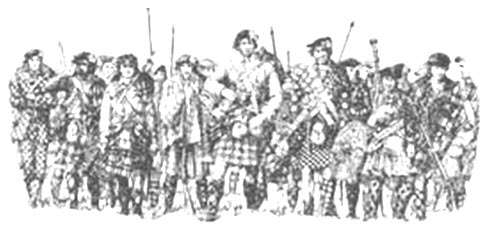


xxxxxAs we have seen, having landed in Scotland in July 1745 and mustered a sizeable force, the Young Pretender invaded England in the November. He reached Derby, but lack of support forced him to retreat back to the Highlands by the end of the year. Here in April 1746 his force of some 5,000 men joined battle with a much larger army of Redcoats on Culloden Moor, close to Inverness. The Jacobites, made up of Scots, Irish and French, were no match for the disciplined soldiers of the crown, led by the Duke of Cumberland. They were routed within 40 minutes, and a thousand lost their lives. The young prince managed to escape to France, helped in part by Flora MacDonald. She took him to Skye, disguised as a spinning maid. In the meantime the Highlanders were savagely treated. Many were tracked down and executed, and harsh laws were passed against them to reduce the power of the clan chiefs. The Jacobite cause was lost, kept alive only in legend, ballad and romantic literature.
THE BATTLE OF CULLODEN MOOR 1746 (G2)
Acknowledgements
Culloden: by the Anglo-
G2-
xxxxxAs we have seen, having landed in Scotland in July 1745, Charles Edward Stuart, son of the Old Pretender, had rallied a large number of his countrymen to his cause -
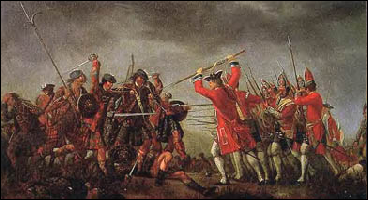 xxxxxAt the Battle of Culloden Moor the Jacobite force of some 5,000 men was heavily outnumbered by the Redcoats, and the fighting quality of the two sides was equally at odds. The English army was a trained and disciplined force, whereas the Jacobites, whilst totally committed to their cause, were not drilled in the art of fighting. Co-
xxxxxAt the Battle of Culloden Moor the Jacobite force of some 5,000 men was heavily outnumbered by the Redcoats, and the fighting quality of the two sides was equally at odds. The English army was a trained and disciplined force, whereas the Jacobites, whilst totally committed to their cause, were not drilled in the art of fighting. Co-
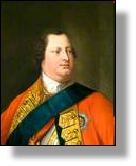
xxxxxItxis hardly surprising that the Duke of Cumberland, third son of George II, should earn the title of "butcher", not only for the battle itself, but for the brutal repression of the Highlanders in the years that followed. In contrast, on his return to England, the great George Frederick Handel composed "See the Conquering Hero Come" in his honour, and a flower, the Sweet William, was named after him -
xxxxxThis battle, the last major engagement to be fought on British soil, put an end to the Jacobite cause. Bonnie Prince Charlie managed to escape the carnage, and his exploits after the battle have been duly romanticised over the years -
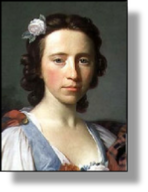
xxxxxRomantic notions aside, Charlie's escape from Scotland in 1746 might not have been possible without the assistance of Flora MacDonald (1722-
xxxxxOn Skye they parted company, but the English got to hear of her part in the escape. She was imprisoned in the Tower of London, but was pardoned the following year. She married three years later, and in 1774 she and her husband emigrated to North Carolina. They eventually returned to Skye, and it was there, at Kingsburgh, that she died, aged 68. The English man of letters Samuel Johnson met her during his visit to Scotland in 1773, and described her as a courageous woman “of soft features, elegant manners and gentle presence.” Like Bonnie Prince Charlie himself, she has become the subject of many romantic ballads and legends.
xxxxxIn the aftermath of the Forty-
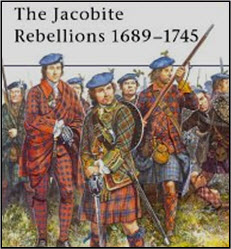
xxxxxFor all intents and purposes, Culloden had put an end to the Jacobite cause, in the military if not the political sense. Perhaps the lack of support for Charles Edward Stuart was not all that difficult to understand. There are those who argue that, had he continued on to London (and got there!), he may well have been successful in gaining the crown. That would seem unlikely. The attitude to monarchy had changed considerably since the reign of James II nearly sixty years earlier, the continual development of parliamentary democracy, though in its infancy, had seen to that. Furthermore, the Young Pretender was regarded as a pawn in the hands of the French, and this was certainly not in his favour. Roman Catholic France, quite apart from being Britain's chief commercial and imperial rival, smacked of absolute government and religious persecution. And south of the border, let's face it, the Scottish Highlanders -
xxxxxIncidentally, the historical background to Tom Jones, the novel by the English novelist Henry Fielding, published in 1749, was based on the Forty-
xxxxx…… The portrait of Flora Macdonald above is by the Scottish artist Allan Ramsay.
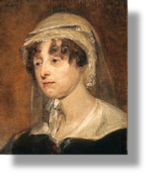
xxxxx…… Thexfamous song about the escape of Bonnie Prince Charlie and the hope for his return, Will ye no’ come back again, was written some years later by the Scottish songwriter Lady Carolina Nairne (1766-
xxxxx…… I myself visited the battlefield of Culloden in 1979 and was moved to write a poem! Should you care to read it please scroll down!
Including:
Flora Macdonald

CULLODEN MOOR
On that fateful day on Culloden Field,
Blade clashed with blade, or hacked upon shield,
There were shots and shouts 'mid a sea of red
Which swept o'er the fallen, the dying, the dead;
And hopes died too, above the glen,
The hopes of a King in the hearts of men,
And the Highlands paid a pitiful price
For the courage of their sacrifice.
I stood today on Culloden Field,
The noise of the battle now stifled, stilled,
No red upon the deep, lush green,
Yet a spirit disturbed that peaceful scene;
Did I not hear, on the edge of the breeze,
The sound of the pipes, faint 'mid the trees,
A ghostly wail with more intent
Than the long sad notes of a Scottish lament?
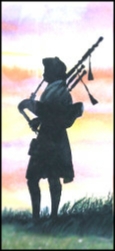
As I took my leave of Culloden Field,
Where we, as a nation, had died and killed,
Where a bold rebellion, halted crushed,
Lay buried deep, its anguish hushed,
I heard again on the wind afloat
The distant cry of a piper's note,
And I pondered anew on those bygone wars
And the spirit born of a long-
August 1979
G2-
Acknowledgement
Poem: public domain and open to improvement!
